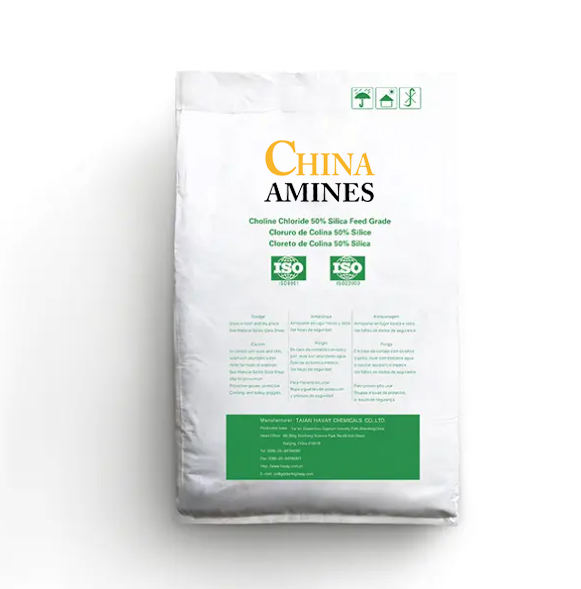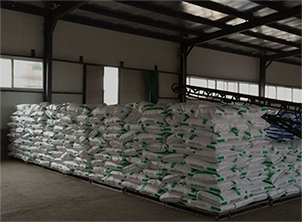1. Chemical Structure and Properties
Active Component: Choline Chloride (C₅H₁₄ClNO)
Structural Formula: [HOCH₂CH₂N⁺(CH₃)₃]Cl⁻ (quaternary ammonium salt)
Carrier Material: Corn Cob Granules (cellulose-based)
Composition: 70% choline chloride adsorbed onto 30% processed corn cob
Physical Properties:
Appearance: Light brown to tan granular solid with mild, earthy odor.
Particle Size: 1–3 mm granules; Bulk Density: ~0.6–0.7 g/cm³.
Moisture Content: <5% (w/w); reduced hygroscopicity due to matrix encapsulation.
Solubility: Choline chloride dissolves in water; corn cob swells but does not dissolve.
Key Features:
- Excellent flowability; minimizes dust during handling.
- Enhanced stability in humid environments thanks to corn cob’s desiccant properties.
2. Industrial Applications
Animal Feed Additive:
- Primary Use: Prevents fatty liver syndrome in poultry and swine; improves feed conversion ratios (FCR).
- Dosage: 500–1,000 g/ton feed (NRC guidelines).
- Compatibility: Suitable for premixes and pelletized feed systems.
Agriculture:
- Use: Foliar sprays and soil amendment; improves nutrient uptake in crops like wheat and maize.
Advantages Over Liquid/Powder Forms:
- Reduced dust exposure and better operator safety.
- Moisture-activated controlled release during feed consumption or soil absorption.
3. Safety and Toxicology
Choline Chloride Hazards:
- Oral Toxicity: Low (LD50 rat: >5,000 mg/kg); Category 5 (practically non-toxic).
- Skin/Eye Contact: Mild irritant; rabbit skin LD50: >2,000 mg/kg.
Corn Cob Carrier:
- GRAS-listed (FDA 21 CFR 582.99); non-toxic, allergen-free, non-carcinogenic.
- OSHA PEL: 15 mg/m³ for inert dust; granular format reduces airborne particulates.
Handling Precautions:
- PPE: Nitrile gloves, dust mask, and safety goggles recommended during bulk handling.
- Storage: Store in cool, dry areas to prevent clumping or moisture uptake.
4. Environmental and Regulatory Compliance
Environmental Impact:
- Biodegradability: Fully compostable; corn cob is an agricultural byproduct.
- Aquatic Toxicity: LC50 (fish, 96h): >100 mg/L; readily biodegradable (OECD 301F).
- Soil Impact: Choline biodegrades to betaine, then CO₂ and H₂O; no harmful residues.
Regulatory Frameworks:
- China: GB/T 23735–2021 compliant feed-grade choline chloride.
- USA: FDA GRAS (21 CFR 582.5250); TSCA-exempt; not regulated under FIFRA.
- EU: Approved as E 3.1.1 for poultry/swine under Feed Additive Regulation (EC 1831/2003); REACH-registered; corn cob not SVHC-listed.
Transport:
- Non-hazardous; transported as standard agricultural product.
5. Case Studies and Application Insights
Case 1: Poultry Feed Efficiency (Brazil, 2023)
- Usage: 800 g/ton feed of 70% corn cob choline chloride.
- Results: 12% reduction in broiler mortality; 7% improvement in FCR.
- Economic Benefit: $1.20/ton cost savings over silica-carrier powder form.
Case 2: Sustainable Swine Farming (EU, 2022)
- Application: Replaced liquid choline chloride in post-weaning piglet diets.
- Outcome: 10% reduction in diarrhea incidence; 5% increase in weight gain.
- Additional Benefit: Lower storage and transport costs due to solid format.
Comparative Analysis:
- Pros: Biodegradable, safer to handle, lower cost, improved palatability in animal diets.
- Cons: Slightly reduced flowability in high-humidity conditions; storage humidity control recommended.



